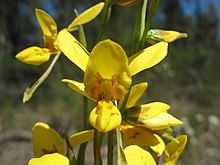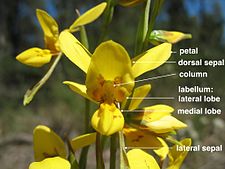| Golden donkey orchid | |
|---|---|

| |
| Georges River, Australia | |
| Scientific classification | |
| Kingdom: | Plantae |
| Clade: | Tracheophytes |
| Clade: | Angiosperms |
| Clade: | Monocots |
| Order: | Asparagales |
| Family: | Orchidaceae |
| Subfamily: | Orchidoideae |
| Tribe: | Diurideae |
| Genus: | Diuris |
| Species: | D. aurea |
| Binomial name | |
| Diuris aurea Sm. | |
| Synonyms | |
| |
Diuris aurea, commonly known as the golden donkey orchid, is a species of orchid which is endemic to Australia, growing in New South Wales and Queensland. It has one or two leaves at the base and two to five golden-yellow to orange flowers with some darker markings.
Description
Diuris aurea is a tuberous, perennial, terrestrial herb, usually growing to a height of 30–60 cm (10–20 in). There are one or two linear leaves, each 10–20 cm (4–8 in) long, 4–6 mm (0.16–0.24 in) wide and channelled.
There are between 2 and 5 golden yellow to orange flowers with some darker markings on the labellum and dorsal sepal. The flower is about 3.5 cm (1 in) wide. The dorsal sepal is broad egg-shaped, 8–15 mm (0.3–0.6 in) long and 7–14 mm (0.3–0.6 in) wide and erect. The lateral sepals are linear to spoon-shaped, 10–25 mm (0.4–1 in) long, 2–5 mm (0.08–0.2 in) wide and hang below the flower, usually parallel to each other. The petals are erect and spread, ear-like above the flower. They are broadly egg-shaped, 7–17 mm (0.3–0.7 in) long, 6–14 mm (0.2–0.6 in) wide on a dark coloured, stalk-like "claw", 5–8 mm (0.2–0.3 in). The labellum is 10–16 mm (0.4–0.6 in) long and is divided into three lobes. The lateral lobes are narrow elliptic to wedge-shaped, 4–6 mm (0.2–0.2 in) long, 2–4 mm (0.08–0.2 in) wide with a few teeth on their edge. The medial lobe is 7–13 mm (0.3–0.5 in) wide with a ridge along its centre line and there is a two-part callus 6–7 mm (0.2–0.3 in) long. Flowering occurs from August to November.

Taxonomy and naming
Diuris aurea was first formally described in 1804 by James Edward Smith and the description was published in his book Exotic Botany (Volume 1). The specific epithet (aurea) is derived from the Latin word aurum meaning "gold".
Distribution and habitat
In New South Wales, golden donkey orchid grows between Marulan and the Hunter Valley, growing in heathy and shrubby woodland and in grassy places in forest in areas near the coast. It also occurs in Queensland where its conservation status is "of least concern".
References
- ^ "Diuris aurea". Australian Plant Census. Retrieved 23 June 2023.
- ^ Robinson, Les (2003). Field guide to the native plants of Sydney (3rd revised ed.). East Roseville, NSW: Kangaroo Press. p. 246. ISBN 9780731812110.
- ^ Jones, David L. "Diuris aurea". Royal Botanic Garden Sydney: plantNET. Retrieved 14 September 2016.
- "Duiris aurea". APNI. Retrieved 14 September 2016.
- Smith, James Edward (1804). Exotic Botany (Volume 1). London: R. Taylor and Co. pp. 14–15. Retrieved 14 September 2016.
- Brown, Roland Wilbur (1956). The Composition of Scientific Words. Washington, D.C.: Smithsonian Institution Press. p. 372.
- "Species profile—Diuris aurea (Orchidaceae)". Queensland Government Department of Environment, land and water. Retrieved 14 September 2016.
- Copeland, Lachlan M.; Backhouse, Gary N. (2022). Guide to the Native Orchids of NSW and ACT. clayton South, Victoria: CSIRO Publishing. p. 206. ISBN 9781486313686.